2.05.2022
Elon Musk shows off new SpaceX rocket engines for Starship. Twitter fans see Daleks.
No, they don't have plungers and scream "Exterminate!" Yes, they will fly in space.
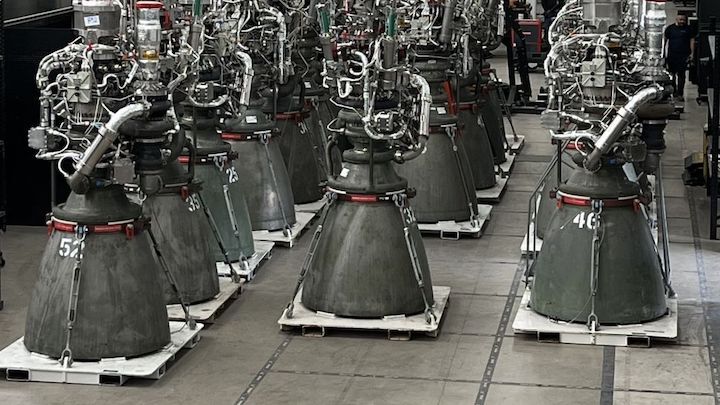
Elon Musk shared this view of a batch of SpaceX Raptor 2 engines awaiting integration into a Starship rocket at the company's Starbase facility near Boca Chica, Texas on April 26, 2022. Twitter fans saw an eerie resemblance to the Doctor Who villians, the Daleks. (Image credit: Elon Musk/SpaceX)
Elon Musk seems pretty proud of his company SpaceX's new rocket engines.
This week, Musk showed off a batch of the new Raptor 2 engines at the SpaceX's Starbase facility in Texas, where they will be used on the first orbital flight of the company's Starship megarocket later this year.
"Raptor 2 rocket engines at Starbase, each producing over half a million pounds (230 tons) of force," Musk wrote in the Twitter post on Tuesday (April 26). Musk's photo showed what appeared to be over a dozen of the new rocket engines, but his Twitter fans saw something else: evil Daleks from Doctor Who.
"It was only a matter of time before he started building Daleks," wrote Twitter user Richard Nellis as the term "Daleks" began trending after Musk's photo post.
"Turns out Elon has created Daleks. Elon IS Davros," wrote Simon, another Twitter user, referring to the creator of the Dalek warriors, who reside inside machines do bear some resemblance to a rocket engine nozzle.
To be clear, Elon Musk has not created a race of evil warriors that cry "Exterminate!" as they take over the world. The Raptor 2 will be the workhorse engine for SpaceX's Starship rockets and their massive Super Heavy boosters.
Each Super Heavy booster will be powered by 33 Raptor 2 engines while the Starship vehicle will use nine Raptor 2 engines of its own. Like SpaceX's veteran Merlin engines on its Falcon 9 rockets, the Raptor 2 is designed to be reusable, as are the Starship and Super Heavy vehicles.
The Raptor 2 is fueled by liquid methane and liquid oxygen, which is a new fuel for SpaceX. It's Falcon 9 rockets use liquid oxygen and rocket-grade kerosene in their Merlin engines.
SpaceX has been developing its Raptor engines for several years, with Raptor 2 as the result. It has a more streamlined design over SpaceX's first version of the Raptor, including less complicated tubing and plumbing lines.
"The V1 kind of looks like a Christmas tree spaghetti pile — a lot of 'fibbly' bits. V2 is greatly simplified while also increasing thrust at the same time," Musk said in a Feb. 10 Starship update.
It may be SpaceX's work to streamline the Raptor 2 that gave it a more Dalek-like resemblance for Doctor Who fans this week. Still, some fans of the sci-fi show were surprised Musk hadn't targeted a different Who villain to emulate.
Quelle: SC
----
Update: 3.05.2022
.
FAA delays SpaceX Starship environmental review for 4th time
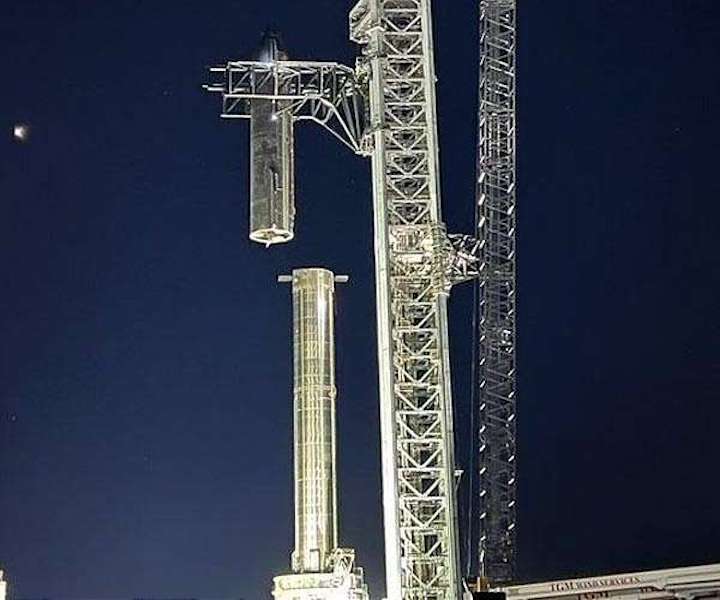
The Federal Aviation Administration announced Friday that it has delayed its environmental review of SpaceX's Starship launch site in Texas for a fourth time.
The review was initially supposed to be completed Dec. 31, 2021. It was pushed back to Feb. 28, then March 28, then April 29, before the latest date -- May 31.
"The FAA is working toward issuing the final Programmatic Environmental Assessment (PEA) for the SpaceX Starship/Super Heavy on May 31, 2022," an emailed statement from the FAA said. "SpaceX made multiple changes to its application that require additional FAA analysis. The agency continues to review around 18,000 general public comments."
SpaceX has been testing its Starship rocket and the Starhopper prototype from the Boca Chica, Texas, site since 2019. The first four attempts to fly and land the Starship ended in fiery explosions, but the most recent, in May, flew to a height of 6 miles and successfully landed at the Starbase spaceport.
The company has been unable to move on to its next round of orbital tests without the FAA review and approval.
SpaceX founder and CEO Elon Musk previously hoped to have an orbital launch by February 2022, but he later said only that it would happen sometime this year.
Starship is a reusable, super heavy-lift launch vehicle that SpaceX plans to use for launching satellites and space probes, serving tourists and traveling to the moon and Mars.
NASA chose SpaceX to land astronauts on the moon using Starship as part of its Artemis missions. The company also sold a private flight around the moon on the rocket to Japanese billionaire Yusaku Maezawa in early 2023.
Quelle: SD
----
Update: 10.05.2022
.
Why is FAA approval for SpaceX Starship orbital launches taking so long?
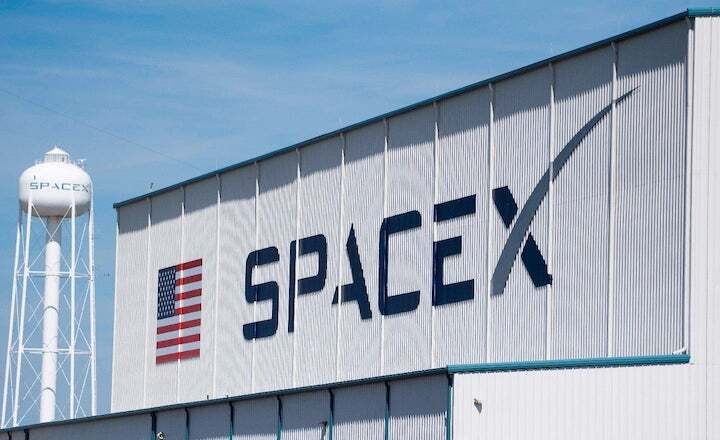
An old joke is going around social media that if the Apollo program had to pass modern environmental regulations, America would never have landed astronauts on the moon. The Federal Aviation Administration (FAA) seems bent on proving the premise of that joke: It recently delayed its environmental review of SpaceX Starship orbital launches from that company’s facility in Boca Chica, Texas for a fourth time.
The latest announcement that the FAA report has been delayed yet again, until the end of May, has caused a proliferation of conspiracy theories on social media. When Ars Technica space reporter Eric Berger reported the latest delay on Twitter, a thread developed in which people chimed in with suggestions that the environmental process was being slow walked or even rigged. One common sentiment is that the FAA is delaying so that the NASA Space Launch System will fly before the orbital SpaceX Starship.
However, a sound principle where government bureaucracy is concerned is to be careful about ascribing to malice what can also be explained by inefficacy common with the federal government.
In announcing the latest delay, it suggests that the reason includes the need to wade through about 18,000 public comments and that SpaceX has made some last-minute changes to the application that has resulted in the need for further analysis, according to CNBC. The announcement raises a number of questions, however.
First, why is the FAA constantly blowing past its own self-imposed deadlines for getting the environmental review completed? Can that agency not perform accurate project estimates?
Second, while the volume of work seems to be enormous, given the stakes, how many resources is the FAA devoting to the review? Could assigning more people speed the process up?
Finally, one wonders whether the FAA comprehends the true importance of the SpaceX Starship and the ability to launch it on a regular basis from the Boca Chica site. The FAA is not evaluating the environmental impact of a new freeway or an office tower. The Starship represents a quantum leap in the United States’ capacity to launch heavy payloads into space.
The Starship is a crucial part of Project Artemis, a NASA-led plan to return astronauts to the moon. The first people back to the moon will ride to the lunar surface on a Starship. Furthermore, according to a recent story in Ars Technica, the Starship will effectively remove traditional mass constraints for any NASA mission anywhere in the solar system. With refueling, the SpaceX rocket ship can deliver 100 metric tons of anything from the surface of Mars to the moons of the outer planets. The introduction of such capability would be a boon to science and exploration.
The recent tests of anti-satellite weapons by Russia and China, as well as Russia’s nuclear saber rattling in the wake of that country’s invasion of Ukraine reminds us that the world is still a dangerous place. More importantly, these events suggest that control of space will be a crucial part of making the world safer against the threats posed by tyrants and terrorists.
The Starship could provide the new United States Space Force the means to operate directly in space on a constant basis. Its ability to put up heavy payloads could counter Russian and Chinese anti-satellite weapons and start to clean up the clouds of space junk that have proven to be a hazard to space navigation.
Recent advances in laser weapons technology achieved by both Israel and the United States Navy suggest that the Starship could fulfill President Ronald Reagan’s dream of a space-based missile defense system that could make nuclear war all but impossible. Considering the blood-curdling threats being issued by Russian President Vladimir Putin and his military to launch nuclear strikes on the West, the sooner that dream can be given form, the better.
The SpaceX facility in Boca Chica is located next to a wildlife sanctuary. SpaceX should take all measures necessary to preserve that sanctuary. But the Kennedy Space Center in Florida has been launching rockets for over six decades while next to the Merritt Island National Wildlife Refuge. Space launches and the environment can coexist in Texas because it has already been done in Florida.
Let this latest delay be the last one the FAA imposes. Let the approval for Starship launches be given with all due speed.
Quelle: The Hill ----
SpaceX rolls out first new Starship prototype in nine months 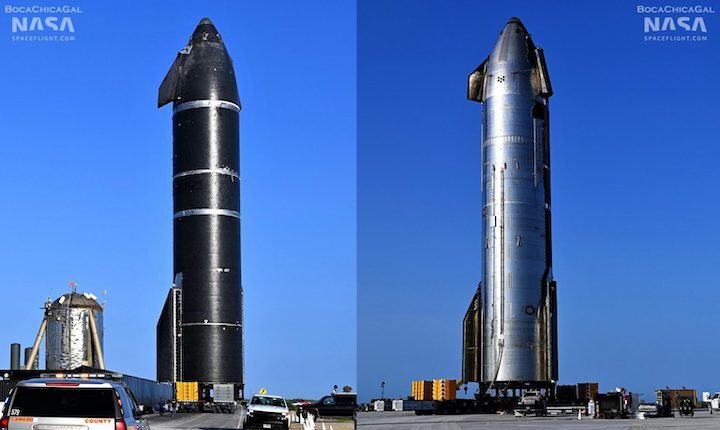
For the first time in more than nine months, SpaceX has rolled a new Starship prototype to its Starbase, Texas launch facilities in the hopes of kicking off qualification testing in the near future.
The new activity exemplifies just how different – and more subdued – Starbase’s last year has been compared to the year prior. However, it also signals new hope for a significantly more eventful 2022 as SpaceX once again finds itself preparing for Starship’s first orbital launch attempt – albeit with an entirely different rocket.
The last time SpaceX rolled a new and functional Starship prototype from the factory to the test stand was on August 13th, 2021, when Starship S20 was transported back to the pad for the second time that month. On August 5th, the same unfinished Starship was stacked on top of Super Heavy booster B4, briefly assembling the largest rocket ever built. With the luxury of hindsight, it’s now clear that that particular milestone was more of a photo-op than a technical achievement. Nonetheless, Ship 20’s path was far more productive than Booster 4’s. The Starship returned to the Starbase factory for a few days of finishing touches before arriving back at the pad on August 13th. Only in the last week of September did Ship 20 finally begin its first significant tests, followed by its first Raptor static fire in mid-October. In mid-November, Ship 20 completed the first of several successful six-Raptor static fires.
Ultimately, by the time Ship 20 was retired in May 2022, the Starship was arguably fully ready to attempt to reach orbit or at least perform some kind of ambitious hypersonic test flight. However, Super Heavy Booster 4 never made it even a fraction of the way to a similar level of flight readiness and SpaceX never received the FAA environmental approval or launch license needed for an orbital launch attempt.
Only now, in May 2022, does it finally look likely that SpaceX will finally receive the necessary permissions for a limited orbital test flight campaign in the near future. While it’s hard to say if Booster 4 and Ship 20 could have supported some kind of launch campaign if permission had been granted months ago, what’s clear is that all aspects – flight hardware, pad hardware, and bureaucracy – have been chronically delayed to the point that Booster 4 and Ship 20 are now heavily outdated.
In their place, now, stand Super Heavy B7 and Starship S24 – the new ‘chosen ones’ assigned to Starship’s orbital launch debut. Both feature extensive design changes and account for an upgraded version of the Raptor engine and countless lessons learned over the better part of a year spent troubleshooting and testing their predecessors. While it did get off to a rocky start, Booster 7 has already completed several cryogenic proof tests and is in the middle of being outfitted with 33 new Raptor engines.
On the other hand, perhaps indicating SpaceX’s satisfaction with Ship 20’s performance, Starship S24 has been on the back burner in comparison. Only on May 26th, 2022 did SpaceX finally finish the prototype to the point that it was ready to begin qualification testing. Missing hundreds of TPS tiles and an aerocover cap, Ship 24 was quickly moved into position at a sort of drive-by test stand where it appears the prototype will first need to pass basic pressure and cryogenic proof tests.
If it passes those tests, SpaceX will then install Ship 24 on a suborbital launch and test stand (Suborbital Pad A) that has been significantly modified for qualification testing. Rather than leaping straight into static fires, SpaceX will minimize the risk of catastrophic failure by first using hydraulic rams to simulate the thrust of six Raptor V2 engines while Starship’s steel tanks and plumbing are chilled to cryogenic temperatures. Only after Ship 24 completes stress testing will SpaceX install new Raptor engines and prepare to replicate Ship 20’s success with several static fires.
Thanks to Raptor V2’s improvements, Ship 24 will likely need to withstand around 1400 tons (~3.1M lbf) of thrust at liftoff – almost 25% more than Ship 20 ever experienced. Beyond a sturdier thrust section, Ship 24 is also the first Starship SpaceX has outfitted with a next-generation nose; the first with a significant landing propellant (‘header’) tank redesign; and the first with a potentially functional payload bay and door.
Assuming Ship 24 passes all planned cryoproof and thrust simulation tests, it remains to be seen if SpaceX will return the Starship to Starbase factory facilities or – like with Ship 20 – install Raptors and finish its heat shield and thermal protection while sitting on the test stand. SpaceX has two test windows currently scheduled: one from 6am to 12pm CDT on Friday, May 27th and the other from 10am to 10pm CDT on Tuesday, May 31st. Quelle: TESLARATI
----
FAA delays environmental review of SpaceX's Starship 2 more weeks, to June 13
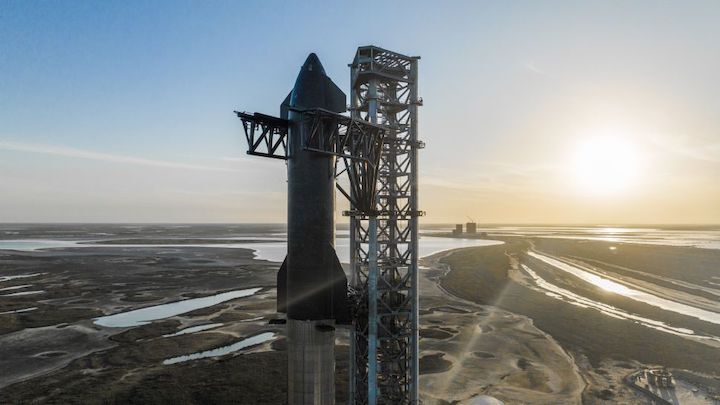
The U.S. Federal Aviation Administration (FAA) has delayed the completion of its environmental review of SpaceX's Starship program by another two weeks, to June 13.
That review, known as a programmatic environmental assessment (PEA), is gauging the environmental impacts of SpaceX's Starbase site in South Texas, where the company builds and tests its giant Starship vehicle.
The FAA released a draft PEA last September, saying at the time that the final report would likely be done by the end of the year. But the agency has repeatedly pushed the deadline back, saying it needs more time to consult with other government departments and analyze the thousands of public comments submitted in response to the draft
You can get updates and read the draft PEA and related documents at the FAA's Starship page(opens in new tab).
Starship consists of a huge first-stage booster called Super Heavy and a 165-foot-tall (50 meters) upper-stage spacecraft known as Starship. Both of these elements are designed to be fully and rapidly reusable.
SpaceX and its founder and CEO, Elon Musk, envision Starship as a potentially revolutionary advance, a system that could make Mars colonization and a variety of other ambitious exploration feats economically feasible.
NASA sees considerable promise in Starship; the agency selected the vehicle to be the first crewed lunar lander for its Artemis program, which aims to put astronauts on the moon in the next few years.
SpaceX has conducted a number of high-altitude test flights of Starship prototypes at Starbase over the past few years, but it's working toward something much bigger: the system's first-ever orbital test mission. That flight will be the first that involves a Super Heavy booster. (On the test hops to date, Starship upper stages have flown solo.)
SpaceX cannot launch the orbital test mission without a passing grade from the final PEA. And that's not the only regulatory box that needs to be checked.
"The completion of the PEA will not guarantee that the FAA will issue a launch license," FAA officials wrote in an email that announced the latest PEA delay. "SpaceX's application also must meet FAA safety, risk and financial responsibility requirements."
Quelle: SC
----
Update: 15.06.2022
.
SpaceX closer to launching giant rocketship after FAA review
SpaceX has cleared a key hurdle for its plan to launch a gigantic, futuristic rocketship into orbit from Texas
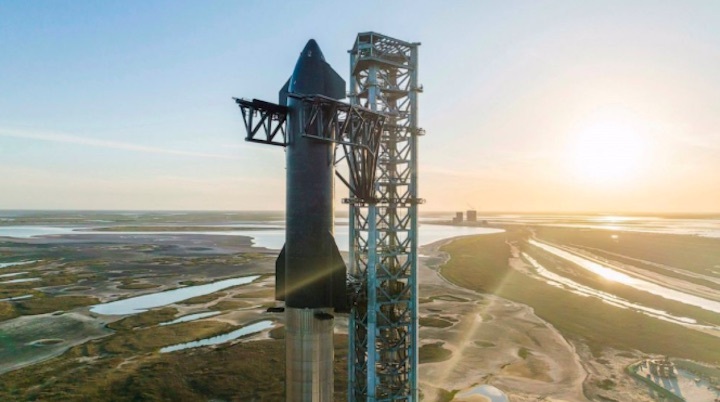
CAPE CANAVERAL, Fla. -- SpaceX cleared a key hurdle Monday for its plan to launch a gigantic, futuristic rocketship into orbit from Texas.
The Federal Aviation Administration concluded an environmental review of Elon Musk’s Starship base. The agency saw no significant environmental concerns, but is requiring more than 75 actions to reduce impacts to the region.
It’s no guarantee a launch license will be issued since other factors such as safety and financial responsibility requirements still must be met at the Boca Chica site, according to the FAA.
After the latest news, SpaceX tweeted: "One step closer to the first orbital flight test of Starship."
At nearly 400 feet (120 meters), Starship is the most powerful rocket ever built and meant to carry people to the moon and Mars. NASA intends to use it for the space agency's lunar landing of astronauts, planned no earlier than 2025.
While SpaceX has launched Starship’s bullet-shaped upper stage several miles (10 kilometers) into the air over the past year — resulting in some spectacular explosions — it’s yet to fly it atop a Super Heavy booster.
Some residents had opposed Starship launches and landings, citing not only the noise and closed roads, but also wreckage raining down from failed flights. As part of the FAA report, the U.S. Fish and Wildlife Service insisted on additional measures, but noted operations were unlikely to jeopardize endangered species or their habitat.
The site is located at the southernmost tip of Texas, about 1,000 miles west of Cape Canaveral where SpaceX launches astronauts and supplies to the International Space Station for NASA.
Quelle: abcNews
----
Update: 8.07.2022
.
SpaceX rolls Starship prototype to launch pad ahead of orbital test flight (photos)
Ship 24 just made a big move.
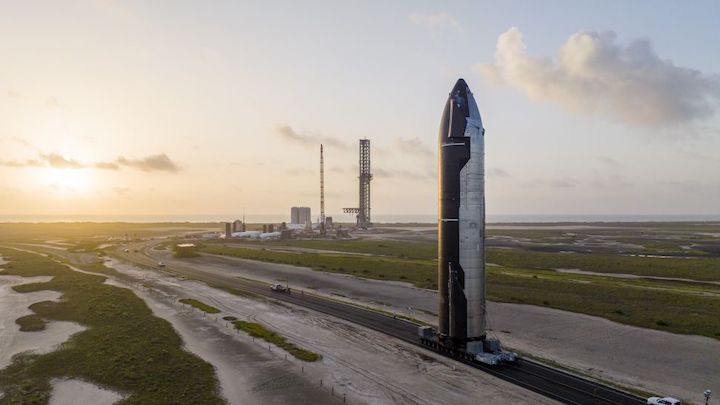
The SpaceX Starship prototype Ship 24 rolls to the launch pad at the company's Starbase facility in South Texas. SpaceX shared this photo via Twitter on July 6, 2022. (Image credit: SpaceX via Twitter)
We may not have to wait too much longer for the first-ever orbital test flight of SpaceX's Starship deep-space transportation system.
SpaceX is developing Starship to carry people and cargo to Mars, the moon and other far-flung destinations. The system consists of two elements, both of which are designed to be fully and rapidly reusable: a huge first-stage booster called Super Heavy and a 165-foot-tall (50 meters) upper-stage spacecraft called Starship.
Starship prototypes have conducted a handful of high-altitude test flights to date, but the vehicle has yet to go orbital. SpaceX plans to change that soon; the company is gearing up to launch an orbital test mission with the system, which will also mark the spaceflight debut of Super Heavy.
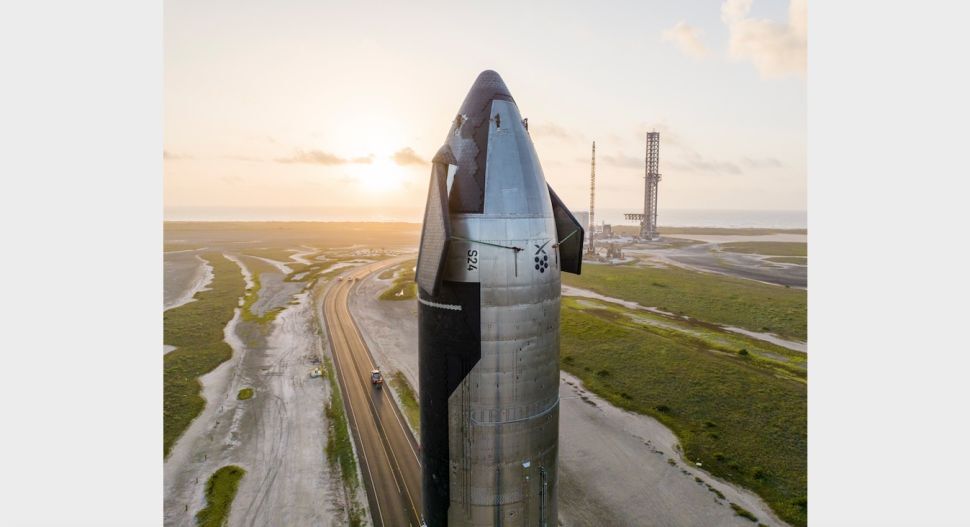
Another shot of Ship 24 on the move toward the launch pad at SpaceX's Starbase facility, posted on Twitter by the company on July 6, 2022. (Image credit: SpaceX via Twitter)
And those preparations are ramping up. Ship 24, the Starship vehicle that will fly the orbital mission, just rolled out to the launch pad at Starbase, SpaceX's South Texas facility, company representatives announced via Twitter today(opens in new tab) (July 6). In that same post, SpaceX shared three photos of the big spacecraft on the move.
Ship 24 will launch atop a Super Heavy known as Booster 7. That rocket is already at the pad and may conduct a static fire test — a prelaunch trial in which a rocket's engines are lit while the vehicle stays anchored to the ground — in the coming days.
Both Starship and Super Heavy are powered by SpaceX's next-generation Raptor engine. The spacecraft sports six Raptors, and the booster features a whopping 33, as SpaceX showed in another recent Twitter post(opens in new tab) that shared photos of both vehicles with all of their engines installed.
For comparison, SpaceX's workhorse Falcon 9 rocket incorporates nine of the company's Merlin engines in its first stage and one Merlin in its upper stage. And Merlins are considerably smaller and less powerful than Raptors.

This image, which SpaceX posted on Twitter on July 6, 2022, shows Ship 24 on the move toward the launch pad with the Super Heavy known as Booster 7 in the foreground. (Image credit: SpaceX via Twitter)
SpaceX recently cleared a significant regulatory hurdle on the road to Starship's first orbital launch: Last month, the U.S. Federal Aviation Administration (FAA) announced that SpaceX could continue its Starship work at Starbase, provided the company takes more than 75 actions to mitigate the effects of that work on the surrounding area, which is a biodiversity hotspot.
There are other such boxes to check, however; for example, the FAA must still grant SpaceX a launch license ahead of the upcoming orbital attempt.
Quelle: SC
----
Update: 13.07.2022
.
Fireball briefly engulfs SpaceX's huge Starship booster during test
Booster 7 just breathed fire — but not in the way SpaceX intended.
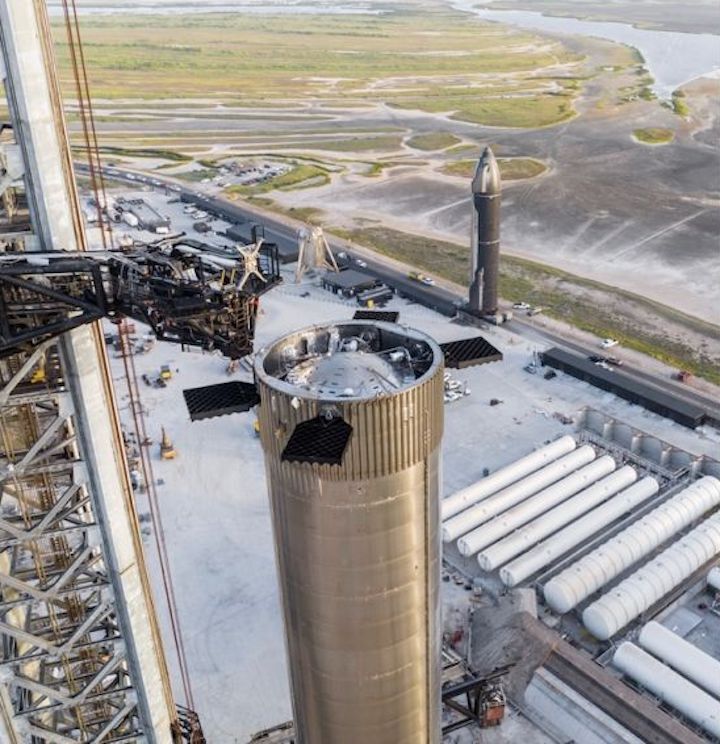
This image, posted on Twitter by SpaceX on July 6, 2022, shows the Starship vehicle known as Ship 24 on the move toward the launch pad with the Super Heavy called Booster 7 in the foreground. (Image credit: SpaceX via Twitter)
SpaceX just lit a very big candle — by accident, it would seem.
A fireball erupted at the base of Booster 7 — a prototype of Super Heavy, the huge first stage for SpaceX's next-gen Starship deep-space transportation system — during a test Monday (July 11) at the company's Starbase facility in South Texas.
The blaze was unintentional, SpaceX founder and CEO Elon Musk said via Twitter on Monday evening.
"Yeah, actually not good. Team is assessing damage," Musk tweeted(opens in new tab). The fireball resulted when an "engine spin start test" did not go according to plan, he explained in another Twitter post(opens in new tab).
SpaceX is prepping Booster 7 for the first-ever Starship orbital test flight. That landmark mission could lift off in the next few months, if all goes according to plan (and if Booster 7 wasn't too badly damaged by Monday's events, which NASASpaceflight streamed live(opens in new tab)).
The Starship system consists of Super Heavy and a 165-foot-tall (50 meters) upper-stage spacecraft called Starship. Both of these elements will be fully and rapidly reusable, potentially making Mars colonization and other ambitious exploration feats economically feasible, Musk has said.
Starship is powered by SpaceX's brawny new Raptor engine — 33 for the booster and six for the upper-stage spacecraft. Booster 7 sports a full complement of Raptors.
SpaceX has launched several upper-stage Starship prototypes on high-altitude test flights, even sticking the landing with one of them in May 2021. But the upcoming mission, which will send a Starship vehicle known as Ship 24 to orbit, will be the first-ever launch for a Super Heavy.
SpaceX is developing Starship to take people and cargo to the moon, Mars and other faraway destinations. NASA selected the system to be the first human lander for Artemis, the agency's moon exploration program. NASA aims to put astronauts down near the moon's south pole using Starship in 2025 or 2026.
Fireball sends SpaceX Super Heavy booster back to the factory
SpaceX has returned an upgraded Super Heavy booster to the factory after an unexpected explosion and fireball caused “minor” damage during testing.
CEO Elon Musk first revealed that the company would need to remove the rocket from Starbase’s orbital launch pad for inspections and repairs on July 13th, about a day and a half after the anomaly. On July 11th, during what may have been a partial wet dress rehearsal (WDR), a dispersed cloud of methane gas found an accidental ignition source and exploded with a force that at least one observerestimated was equivalent to several pounds of TNT. Several nail-biting hours of uncertainty followed, during which SpaceX attempted to empty Super Heavy Booster 7 of its propellant (and explosive potential) and regain control of the situation, while simultaneously trying to avoid stoking a fire that started at the pad.
With a heaping serving of luck, Booster 7 made it through the event (mostly) intact. Now SpaceX must take a close appraisal of the rocket and situation and decide how to proceed.
Musk, as always, has put his optimistic face forward on Twitter and in a direct response to Reuters. According to an email sent shortly after an early in-person post-anomaly inspection, Musk stated that Booster 7 could return “to the launch stand probably next week” – implying that any damage suffered was extremely minor. By the time Super Heavy was removed from the launch mount the next day (July 14th), however, it became clear that the situation wasn’t quite as optimal.
Instead, Booster 7’s aft engine section was clearly damaged, with some of the dozens of thermal protection panels enclosing 33 Raptor engines apparently torn off or knocked askew by the July 11th blast. Given the tight fit and relatively heavy-duty nature of some of those panels, deformation could easily damage some of the more sensitive plumbing and components on Raptor engines. The day prior, teams spent hours tearing out unexpectedly fragile components of Booster 7’s hidden aft heat shielding and even removed and replaced one of its Raptors in-situ.
More likely than not, all Raptor engines with minor damage can be repaired and reused on a future booster. The explosion may also give SpaceX invaluable data that can be used to improve the durability and performance of Raptor and Super Heavy’s heat shield. Nonetheless, a methodical inspection of Booster 7’s aft end could easily take a week or two. If more chronic damage is discovered or the whole aft heat shield or a large number of Raptors need to be removed and replaced, the hiatus could grow to a month or more.
Following Booster 7’s July 15th return to the Starbase factory, SpaceX appears to have begun removing more Raptor engines on July 17th, kicking off a phase that will hopefully be heavy on encouraging inspection results and light on substantial repairs. If it turns out that the Super Heavy prototype is mostly in great shape after such a violent anomaly, it would bode well for the rocket’s durability during future ground and flight testing. If it did not fare well, SpaceX may need to seriously reconsider whether Booster 7 is fit to support Starship’s orbital launch debut or even proceed into static fire testing.
Either way, SpaceX recently finished stacking Super Heavy Booster 8. If it’s made a priority, the newest prototype could be made ready to take over where Booster 7 left off within a few weeks. Alternatively, it could even join a repaired Booster 7 at the launch pad for basic proof testing while its predecessor attempts to restart its first static fire campaign. Simultaneously, Starship S24 is almost ready to begin its own static fire test campaign, guaranteeing an eventful and hardware-rich period at Starbase after several months of relative inaction.
SpaceX has 12-hour road closures likely meant for Ship 24 testing scheduled daily from Monday, July 18th to Thursday, July 21st.
Quelle: TESLARATI
----
Update: 12.08.2022
.
SpaceX's Starship won't launch on 1st orbital test flight this month
The company is apparently targeting a six-month window that opens on Sept. 1.
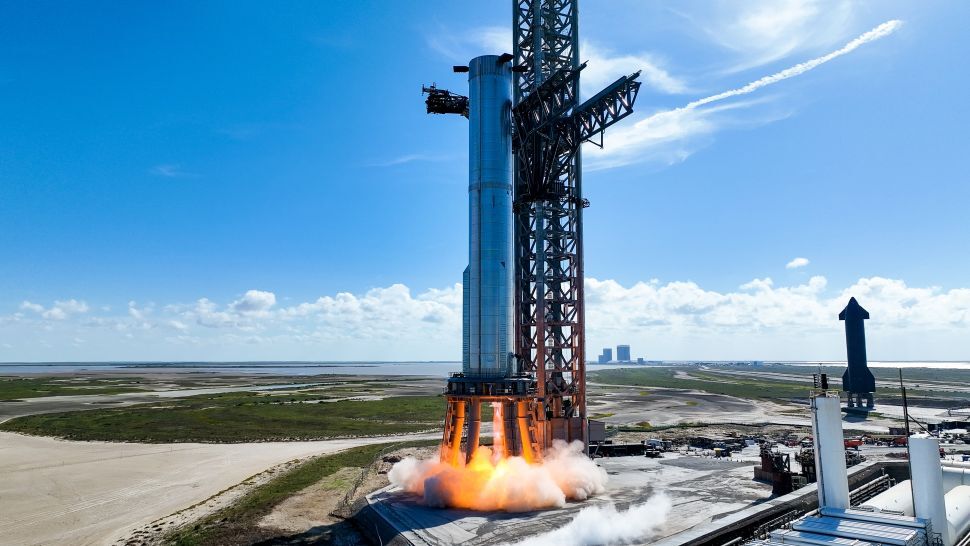
SpaceX conducts a static-fire test with one of the Super Heavy's 33 Raptor engines on Aug. 9, 2022, at its Starbase site in South Texas. (Image credit: SpaceX)
The first orbital test flight of SpaceX's Starship vehicle won't get off the ground in August.
SpaceX is targeting a six-month window that opens on Sept. 1 for the highly anticipated mission, according to a radio-spectrum license application(opens in new tab) that the company filed with the U.S. Federal Communications Commission (FCC).
That license was granted on Wednesday (Aug. 10), according to the Twitter account FCC Space Licenses(opens in new tab), which keeps tabs on such things. But this approval is not the final regulatory hurdle that Starship must clear on the way to the launch pad.
"Reminder, this is not the same as a launch license. It is a specific radio license for the test vehicles and does not indicate a change in status. Please do not make a YouTube video or write a 20,000 [word article] about this," FCC Space Licenses, which is not a U.S. government account, wrote in another Wednesday tweet(opens in new tab). (This article is only about 400 words long, so hopefully it's still in bounds.)
SpaceX apparently still hasn't received a launch license for the Starship orbital test flight, which will lift off from the company's Starbase facility in South Texas. Launch licenses are the purview of the U.S. Federal Aviation Administration, which recently wrapped up a lengthy environmental assessment of Starship activities at the site.
Starship consists of a giant first-stage booster called Super Heavy and a 165-foot-tall (50 meters) upper-stage spacecraft known as Starship. Both elements are designed to be fully reusable, and both will be powered by SpaceX's next-generation Raptor engines — 33 for Super Heavy and six for Starship.
The duo that will fly the coming orbital mission are Booster 7 and Ship 24. SpaceX has begun prepping both prototypes for the task; for example, the company conducted "static fire" engine tests with both vehicles on Tuesday (Aug. 9) at Starbase.
Booster 7 lit just one of its 33 engines on Tuesday, and Ship 24 fired up two of its six Raptors. So a lot of work remains before SpaceX clears the duo for an orbital flight — meaning it was never likely that the mission would lift off in August, even if all the paperwork were already in order.
There is a high-profile launch scheduled for this month, however: NASA is currently targeting Aug. 29 for the liftoff of Artemis 1, the first mission in its Artemis program of moon exploration. Artemis 1 will use a Space Launch System rocket to send an uncrewed Orion capsule on a roughly six-week mission to lunar orbit and back.
Quelle: SC
----
Update: 24.08.2022
.
SpaceX adds Falcon 9 back to second-gen Starlink launch plan
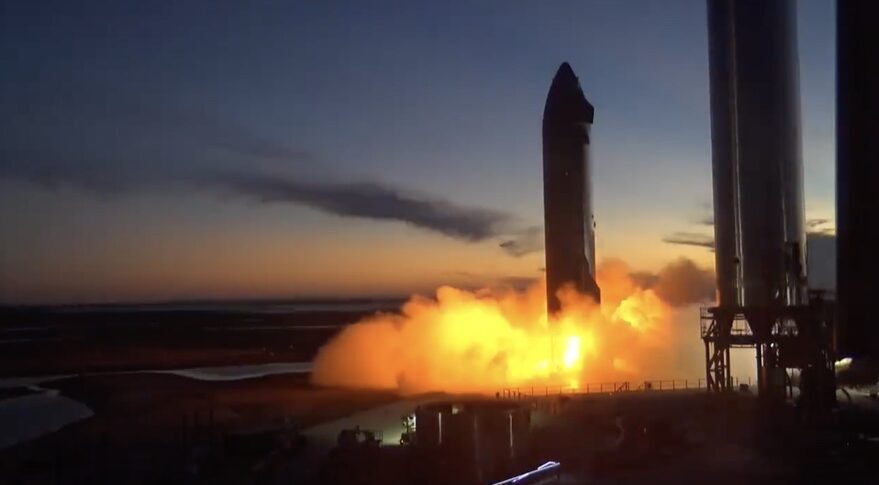
TAMPA, Fla. — SpaceX has decided to use a mix of Falcon 9 and Starship rockets to launch the 30,000 satellites in its proposed second-generation Starlink broadband constellation.
Launching some of the satellites with SpaceX’s “tested and dependable Falcon 9” will accelerate the constellation’s deployment to improve Starlink services. SpaceX director of satellite policy David Goldman wrote in an Aug. 19 letter to the Federal Communications Commission.
Goldman did not say when SpaceX could start launching the second-generation constellation, which remains subject to FCC approval.
In January, SpaceX said it had picked a configuration for the low Earth orbit (LEO) network that leverages Starship, the delayed super-heavy-lift vehicle the company is developing in Boca Chica, Texas.
The Federal Aviation Administration completed a lengthy environmental assessment in June that would allow Starship launches from Boca Chica. However, SpaceX must first implement dozens of measures to mitigate environmental effects.
Starship is designed to send more than 100 tons of payload to LEO, versus under 23 tons for SpaceX’s Falcon 9 workhorse.
SpaceX has also previously said second-generation Starlinks deployed via Starship could enter service within weeks after launch, rather than months following a Falcon 9 mission.
“While SpaceX will use technically identical satellites on both rockets, the physical structures will be tailored to meet the physical dimensions of the rockets on which they will be launched,” Goldman told the FCC.
Elon Musk, SpaceX’s CEO, has said full-sized second-generation Starlinks are seven meters long and weigh about five times more than its first generation at around 1,250 kilograms.
Goldman said SpaceX remains committed to deploying all of its 29,988 proposed second-generation satellites — at altitudes of between 340 and 614 kilometers across nine inclined orbits — whether they are launched with Falcon 9 or Starship.
“Specifically, SpaceX plans to launch satellites for its Gen2 constellation beginning with its three 500-kilometer shells, followed by satellites in its lower-altitude shells,” he said.
“The result will be that more Americans will receive high-quality broadband faster.”
SpaceX’s constellation plans face opposition from companies, including satellite broadband operator Viasat, which wants the FCC to perform an environmental review before approving the second-generation network.
SpaceX has launched more than 3,100 satellites for Starlink’s current generation with Falcon 9, usually in batches of around 50 per mission. According to astronomer and spaceflight analyst Jonathan McDowell, more than 2,800 are currently working in LEO.
The company has said its second generation would provide denser rural coverage and improved performance while being compatible with existing Starlink user terminals.
SpaceX currently has permission to deploy 4,408 satellites in LEO for a network that uses Ku-band spectrum to connect users from around 550 kilometers above the Earth.
A separate FCC authorization also gives SpaceX permission to launch 7,500 V-band satellites, which Starlink’s first generation needs to reach a total of around 12,000 satellites for global services.
Quelle: SN
----
Update: 11.09.2022
.
SpaceX Starship prototype ignites six engines, starts major brush fire
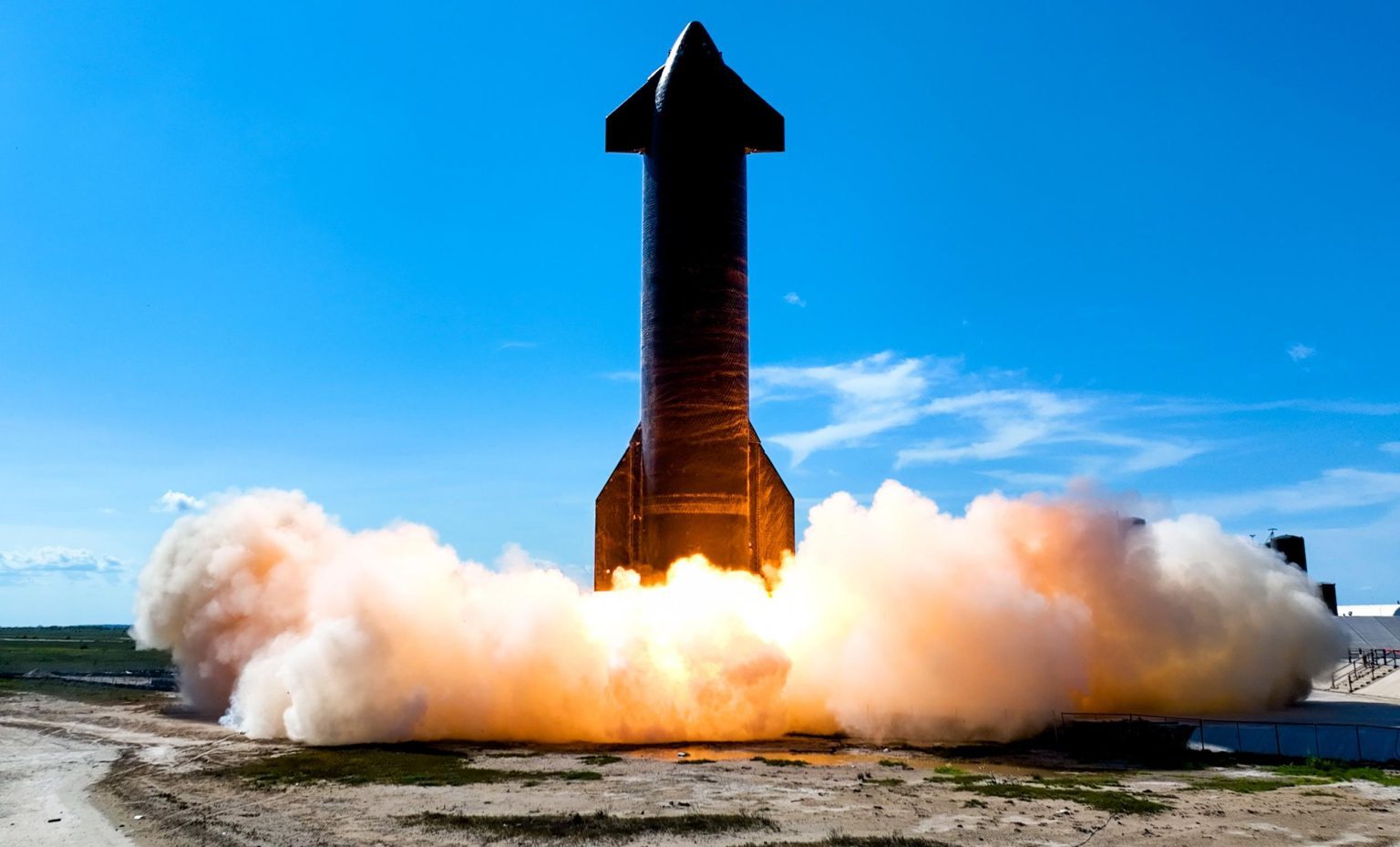
SpaceX has successfully ignited all six engines on its latest Starship prototype, taking a significant step towards ensuring that the upper stage will be ready for the rocket’s first orbital launch attempt.
Unfortunately, the same successful static fire of a Starship upper stage – potentially producing almost twice as much thrust as the booster of SpaceX’s Falcon 9 rocket – scattered superheated debris hundreds of meters away, igniting a major brush fire. It’s not the first major fire caused by Starship activities in South Texas, and it likely won’t be the last.
Starship S24 completed its first successful static fire on August 9th, igniting two Raptor engines. Several unsuccessful attempts to test more engines followed throughout the rest of the month, and SpaceX ultimately decided to replace one of Starship S24’s three Raptor Vacuum engines in early September before trying again. After workers installed the new engine and buttoned up Ship 24, the stars eventually aligned on September 8th.
Kicking off the test, SpaceX pumped several hundred tons of liquid oxygen (LOx) and a much smaller quantity of liquid methane (LCH4) fuel into Ship 24 in about 90 minutes, producing a crisp layer of frost wherever the cryogenic liquids touched the skin of the rocket’s uninsulated steel tanks. No frost formed on Starship’s upper methane tank, implying that SpaceX only loaded methane fuel into internal ‘header’ tanks meant to store propellant for landings. The hundreds of tons of liquid oxygen, then, were likely meant as ballast, reducing the maximum stress Starship could exert on the test stand holding it to the ground.
That potential stress is substantial. Outfitted with upgraded Raptor 2 engines, Starship S24 could have produced up to 1380 tons (~3M lbf) thrust when it ignited all six for the first time at 4:30 pm CDT. On top of smashing the record for most thrust produced during a Starbase rocket test, Ship 24’s engines burned for almost 8 seconds, making it one of the longest static fires ever performed on a Starship test stand.
Several brush fires were visible almost immediately after clouds of dust and steam cleared. More likely than not, the combination of the extreme force, heat, and burn duration likely obliterated the almost entirely unprotected concrete surface below Ship 24. Despite continuous evidence that all Starship static fire operations would be easier and safer with the systems, SpaceX still refuses to install serious water deluge or flame deflector systems at Starbase’s test stands and launch pads.
Instead, under its steel Starship test stands, SpaceX relies on a single middling deluge spray nozzle and high-temperature concrete (likely martyte) that probably wouldn’t pass muster for a rocket ten times less powerful than Starship. In multiple instances, Starships have shattered that feeble martyte layer, creating high-velocity ceramic shards that damage their undersides or Raptor engines, requiring repairs and creating risky situations. With essentially no attempt at all to tame the high-speed several-thousand-degree Raptor exhaust, static fire tests at Starbase thus almost always start small grass fires and cause minor damage, but those fires rarely spread.
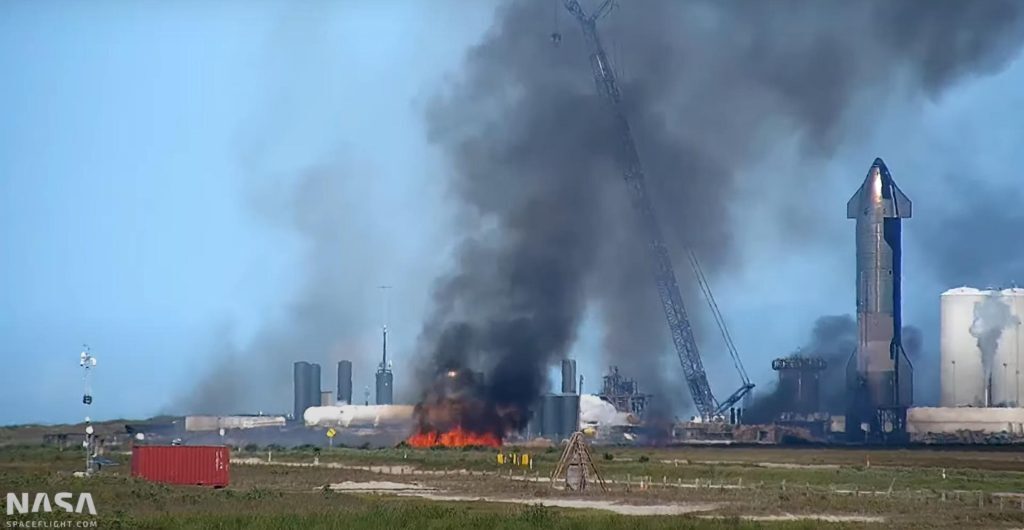
It appears that September 8th’s accidental brush fire burned at least several dozen acres. (NASASpaceflight)
Ship 24’s first six-engine test was not so lucky, although the Starship made it through seemingly unscathed. Most likely, eight long seconds of blast-furnace conditions melted the top layer of surrounding concrete and shot a hailstorm of tiny superheated globules in almost every direction. Indeed, in almost every direction there was something readily able to burn, a fire started. In several locations to the south and west, brush caught fire and began to burn unusually aggressively, quickly growing into walls of flames that sped across the terrain. To the east, debris even made it into a SpaceX dumpster, the contents of which easily caught fire and burned for hours.
Eventually, around 9pm CDT, firefighters were able to approach the safed launch pad and rocket, but the main fire had already spread south, out of reach. Instead, they started controlled burns near SpaceX’s roadblock, hoping to clear brush and prevent the fire (however unlikely) from proceeding towards SpaceX’s Starbase factory and Boca Chica Village homes and residents.
The nature of the estuary-like terrain and wetlands means that it’s very easy to stop fires at choke points, so the fire likely never posed any real threat to Boca Chica residents, SpaceX employees, or onlookers. It was also unlikely to damage SpaceX’s launch facilities or return to damage Starship S24 from the start, as both of are surrounded by a combination of concrete aprons, empty dirt fields, and a highway.
Still, the “brush” burned by the fire is a protected habitat located in a State Park and Wildlife Refuge. While fire is a natural and often necessary element of many habitats, including some of those in Boca Chica, this is the second major brush fire caused by Starship testing since 2019, which may be less than desirable. At a minimum, fighting fires around Starbase generally requires firefighters to walk or even drive on protected wetlands and salt flats, the impact of which could ultimately be as bad for wildlife and habitats as the fire itself.
SpaceX’s Federal Aviation Administration (FAA) Programmatic Environmental Assessment (PEA), which fully greenlit the company’s existing Starbase Texas facilities and launch plans earlier this year, only discusses fire [PDF] a handful of times. Repairing and preventing future damage to wetlands, however, comes up dozens of times and is the subject of numerous conditions SpaceX must meet before the FAA will grant Starship an orbital launch license.
Ultimately, given that the FAA approved that PEA in full awareness of a 2019 brush fire caused by Starhopper (an early Starship prototype) that may have been as bad or worse than 2022’s, there’s a chance that it will play a small role in the ongoing launch licensing process, but the odds of it being a showstopper are close to zero. Still, it would likely benefit SpaceX at least as much as the surrounding Boca Chica wilderness if it can implement changes that prevent major brush fires from becoming a regular ‘accidental’ occurrence.
